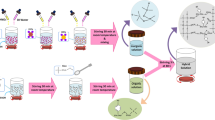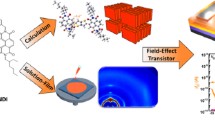Abstract
Organic thin film transistors (OTFTs) based on poly(3-hexylthiophene) (P3HT)/Zinc oxide (ZnO) nanorods composite films as the active layers were prepared by spray-coating process. The OTFTs with P3HT/ZnO-nanorods composite films owned higher carriers mobility than the OTFT based on pure P3HT. It can be found that the mobility of OTFTs increased by 135% due to ZnO-nanorods doping. This was attributed to the improvement of the P3HT crystallinity and the optimization of polymer chains orientation. Meanwhile, because of the distinction of work function between P3HT and ZnO, the majority carriers would accumulate on either side of the P3HT-ZnO interface which benefited carrier transfer. The influence on the mobility of composite film was studied. In addition, the threshold voltage of devices changed positively with the increase of ZnO-nanorods due to the decrease of electrostatic potential for P3HT/ZnO-nanorods composite films. The effect could be explained by the energy level theory of semiconductor.
Similar content being viewed by others
References
Wu S, Tai Q, Yan F. Hybrid photovoltaic devices based on poly (3-hexylthiophene) and ordered electrospun ZnO nanofibers. J Phys ChemC, 2010, 114: 6197–6200
Coakley K M, Srinivasan B S, Ziebarth J M, et al. Enhanced hole mobility in regioregular polythiophene infiltrated in straight nanopores. Adv Funct Mater, 2005, 15: 1927–1932
Unalan H E, Hiralal P, Kuo D, et al. Flexible organic photovoltaics from zinc oxide nanowires grown on transparent and conducting single walled carbon nanotube thin films. J Mater Chem, 2008, 18: 5909
Wu M-C, Lin Y-Y, Chen S, et al. Enhancing light absorption and carrier transport of P3HT by doping multi-wall carbon nanotubes. Chem Phys Lett, 2009, 468: 64–68
Tai Q, Zhao X, Yan F. Hybrid solar cells based on poly(3-hexylthiophene) and electrospun TiO2 nanofibers with effective interface modification. J Mater Chem, 2010, 20: 7366
Bouclé J, Chyla S, Shaffer M S P, et al. Hybrid solar cells from a blend of Poly(3-hexylthiophene) and ligand-capped TiO2 nanorods. Adv Funct Mater, 2008, 18: 622–633
Lin Y-Y, Chu T-H, Li S-S, et al. Interfacial nanostructuring on the performance of polymer/TiO2 nanorod bulk heterojunction Solar cells. J AM Chem Soc, 2009. 3644–3649
Yang Y, Guo W, Zhang Y, et al. Piezotronic effect on the output voltage of P3HT/ZnO micro/nanowire heterojunction solar cells. Nano Lett, 2011, 11: 4812–4817
Sun Z, Li J, Liu C, et al. Enhancement of hole mobility of poly(3- hexylthiophene) induced by titania nanorods in composite films. AdvMater, 2011, 23: 3648–3652
Park Y D, Lim J A, Jang Y, et al. Enhancement of the field-effect mobility of poly(3-hexylthiophene)/functionalized carbon nanotube hybrid transistors. Org Electron, 2008, 9: 317–322
Yan F, Li J, Mok S M. Highly photosensitive thin film transistors based on a composite of poly(3-hexylthiophene) and titania nanoparticles. J Appl Phys, 2009, 106: 074501
Kim S, Kwon H-J, Lee S, et al. Low-power flexible organic lightemitting diode display device. AdvMater, 2011, 23: 3511–3516
Rotzoll R, Mohapatra S, Olariu V, et al. Radio frequency rectifiers based on organic thin-film transistors. Appl Phys Lett, 2006, 88: 123502
Li B, Lambeth D N. Chemical sensing using nanostructured polythiophene transistors. Nano Lett, 2008, 8: 3563–3567
Das A, Dost R, Richardson T, et al. A Nitrogen Dioxide Sensor Based on an Organic Transistor Constructed from Amorphous Semiconducting Polymers. Adv Mater, 2007, 19: 4018–4023
Deng J, Wang M, Song X, et al. CdS and CdSe quantum dots subsectionally sensitized solar cells using a novel double-layer ZnO nanorod arrays. J Colloid Interface Sci, 2012, 388: 118–122
Shen Q, Ogomi Y, Das S K, et al. Huge suppression of charge recombination in P3HT-ZnO organic-inorganic hybrid solar cells by locating dyes at the ZnO/P3HT interfaces. Phys Chem Chem Phys, 2013, 15: 14370–14376
Noori K, Giustino F. Ideal energy-level alignment at the ZnO/P3HT photovoltaic interface. Adv Funct Mater, 2012, 22: 5089–5095
Kang D, Liu a, Bian J, et al. Optoelectronic characteristics of Zinc oxide nanorods/P3HT hybrid junctions investigated using surface photovoltage method. ECS Solid State Letters, 2012, 1: 15–17
Li F, Chen W, Yuan K, et al. Photovoltaic performance enhancement in P3HT/ZnO hybrid bulk-heterojunction solar cells induced by semiconducting liquid crystal ligands. Org Electron, 2012, 13: 2757–2762
Mok S M, Yan F, Chan H L W. Organic phototransistor based on poly(3-hexylthiophene)/TiO[sub2] nanoparticle composite. Appl Phys Lett, 2008, 93: 023310
Xie T, Xie G, Zhou Y, et al. Thin film transistors gas sensors based on reduced graphene oxide poly(3-hexylthiophene) bilayer film for nitrogen dioxide detection. Chem. Phys. Lett. 2014, 614: 275–281
Wang L, Kang Y, Liu X, et al. ZnO nanorod gas sensor for ethanol detection. Sensors Actuators B: Chem, 2012, 162: 237–243
von Hauff E, Johnen F, Tunc A V, et al. Detailed investigation of the conducting channel in poly(3-hexylthiophene) field effect transistors. J Appl Phys, 2010, 108: 063709
Chabinyc M L, Lu J-P, Street R A, et al. Short channel effects in regioregular poly(thiophene) thin film transistors. J Appl Phys, 2004, 96: 2063
Jia H, Gowrisanker S, Pant G K, et al. Effect of poly (3-hexylthiophene) film thickness on organic thin film transistor properties. J Vac Sci Technol A, 2006, 24: 1228
Sirringhaus H, Brown P J, Friend R H, et al. Two-dimensional charge transport in conjugated polymers. Nature, 1999, 401: 685–688
Brown P, Thomas D, Köhler A, et al. Effect of interchain interactions on the absorption and emission of poly(3-hexylthiophene). Phys Rev B, 2003, 67: 064203
Brown P, Sirringhaus H, Harrison M, et al. Optical spectroscopy of field-induced charge in self-organized high mobility poly(3-hexylthiophene). Phys Rev B, 2001, 63: 125204
Wang H, Yan D. Organic heterostructures in organic field-effect transistors. Asia Mater, 2010, 2: 69–78
Author information
Authors and Affiliations
Corresponding author
Rights and permissions
About this article
Cite this article
Xie, T., Xie, G., Du, H. et al. The mobility improvement of organic thin film transistors by introducing ZnO-nanrods as an zctive layer. Sci. China Technol. Sci. 59, 714–720 (2016). https://doi.org/10.1007/s11431-016-6039-9
Received:
Published:
Issue Date:
DOI: https://doi.org/10.1007/s11431-016-6039-9




